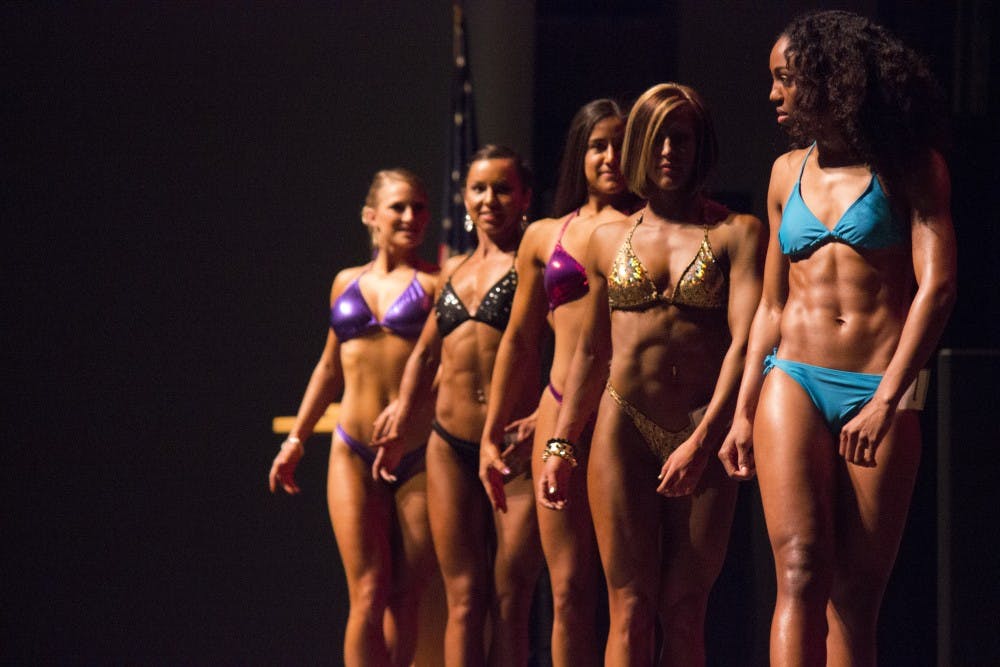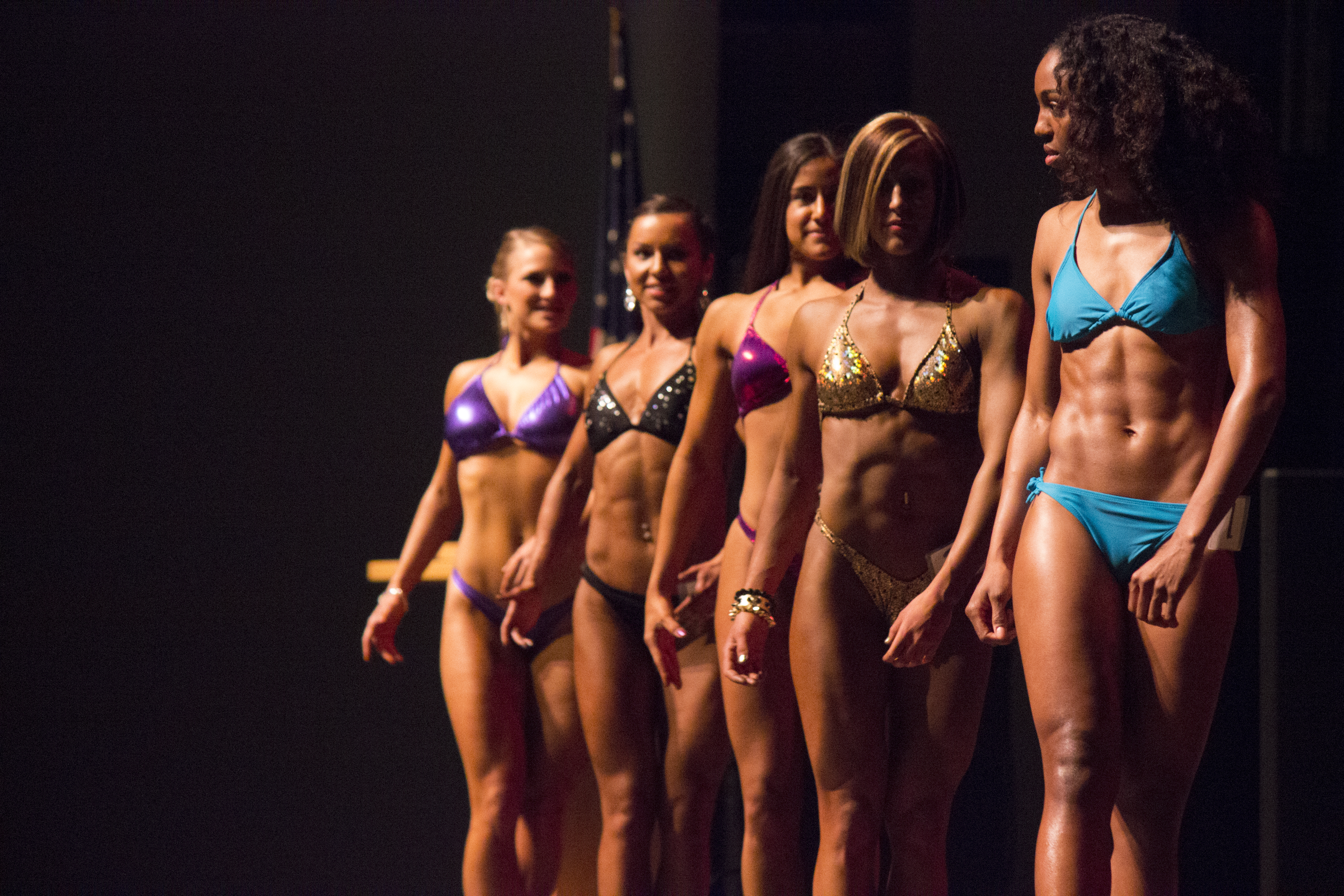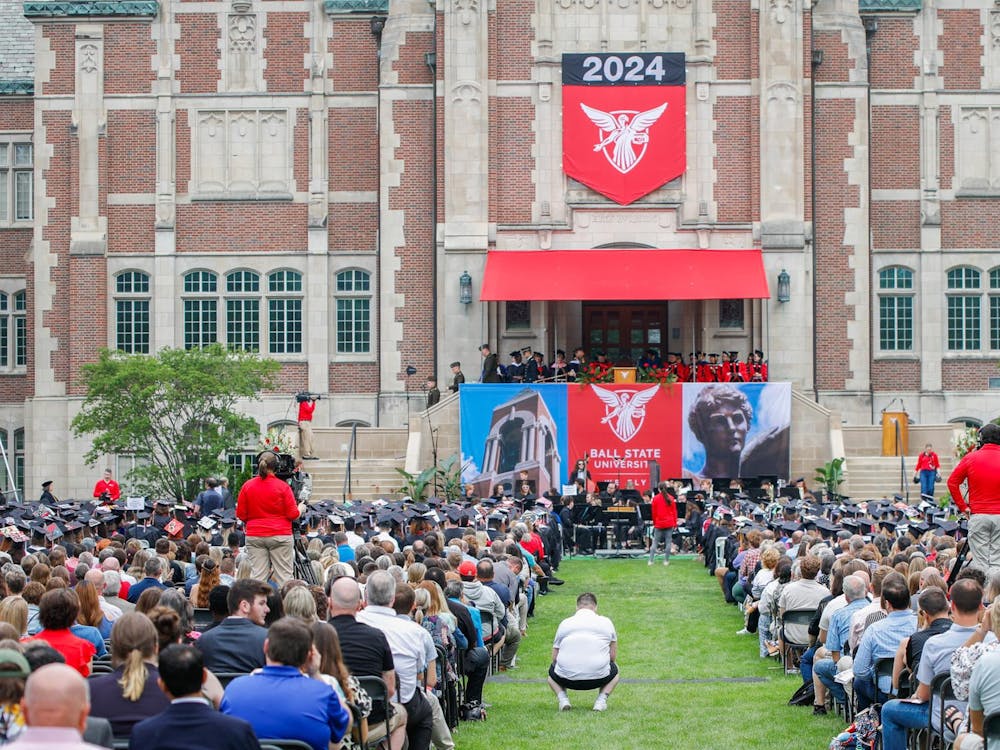Before going to bodybuilding competitions, competitors have to change their diet in order to make their muscles look as defined as possible:
Two days before:
Increase carbohydrates; carbs help to fill out and bulk up muscles. Decrease fat. Drink two gallons of water; keeping hydrated helps to fill out veins.Day of competition: Sugar, it increases energy. Fat because helps feed muscles. Very little water — intentional dehydration helps to define muscles in the short term.Training for competition requires a strict diet in addition to a good workout, both athletes focus on carbohydrate intake:Matsenko:
Maximum: 80 carbs Minimum: 30 carbsFarley: Minimum: 85 carbsWhile competitors aren’t judged on their strength, Matsenko said it is a confidence boost to see how much she can lift.Matsenko:
Bench press: 110-115 pounds, 8-10 repsFarley: Bench press: 135 pounds, 3 reps|
|
|
Female contestants walk out at the beginning of the 2014 Mr. and Ms. Ball State bodybuilding competition on April 17 at John R. Emens Auditorium. DN PHOTO ALISON CARROLL
|
Bodybuilding often conjures up images of orange glow tans and masculine bulk. But for two women on campus, the large, rippling muscles don’t stop them from being feminine.
Ashley Farley, a junior human resources major, and Anika Matsenko, a graduate actuarial science major, found friendship while participating in amateur bodybuilding competing.
Farley was a gymnast for 13 years, but when she came to Ball State, she wanted to try out something new. Initially, Farley said she worked out to relieve stress, eventually joining her boyfriend and his family for cycling.
“My friend from the gymnastics team that I met in high school was like, ‘You should try to do a bodybuilding competition,’” she said. “I ended up doing it and she ended up getting injured and couldn’t do it. I did it by myself and ended up deciding to bodybuild.”
For Matsenko, bodybuilding is a hobby.
Matsenko received her undergraduate degree from Indiana University. A friend from Ball State got involved in bodybuilding and suggested Matsenko try it, too. When she came to Ball State for her graduate degree, she started to seek out how to get involved.“I always liked working out, though probably not this hardcore,” she said. “I’ve always liked the idea of going and working out, getting strong.”
|
Before going to bodybuilding competitions, competitors have to change their diet in order to make their muscles look as defined as possible:
Two days before:
|
She took up a 1,200-calorie diet and workout regiment that cut 10 pounds of fat from her 5-foot-5-inch frame in one month.
Matsenko said the strict diet and cycles of high carbohydrates and low carbohydrates is what helps her create bulk.
Farley and Matsenko said they face certain misconceptions as muscular women. Farley is often frustrated by women who are afraid of being bulky.
“This girl came up to me in the rec center and I helped her, I ran her through a workout,” she said. “She was trying to be nice and said, ‘I want to be toned, but I don’t want to have a ton of muscle.’ You’re not going to look like a man picking up some heavy weights.”
Sometimes, women in the gym are worried that working out may make them look manly. The two said they aren’t worried about that.
“If you’re just trying to look nice ... you’re not going to turn into the Hulk in a week span,” Farley said.
Both women work out between four and seven times a week but sometimes, Farley will work out multiple times a day as a stress reliever.
The hobby takes up much of their free time.
Matsenko said her social life, not her grades, has suffered for bodybuilding.
“When you’re training, you can’t go eat with people,” she said. “You can go out, but you can’t drink. Then there is peer pressure; you don’t want that.”
Her social life isn’t the only thing that has suffered for her hobby. As a professional, her search for suits that accommodate her muscular arms is a struggle.
Dresses, sleeves and beltless pants are nightmares for the women.
Farley said she often finds herself purchasing bigger dress sizes to compensate for her toned back.
She will compete in July in a competition hosted by the National Physique Committee, a national organization for amateur bodybuilders.
She is hoping to reach one of the top two spots in her height class in order to receive her “pro card.” Farley said she hopes to eventually become a professional bodybuilder and turn her passion for physique into a gym that helps train people who want to become bodybuilders.
Matsenko said that bodybuilding will remain a hobby for her. Her passion is in her career.
“For me, I like lifting weights,” Matsenko said. “I like being strong, I like looking good. So, I’ll definitely keep doing it. ... But I’m not going to be a professional bodybuilder.”






